Installing Salt.Box Client
The Salt.Box v0.0.1 distribution uses SaltStack 3006.9 LTS components.
This SaltStack release is a long-term support release.
This means that the release will be supported for a longer period than regular versions.
It is understood that during this period, updates will be released that include security fixes and critical bug fixes, but not new features that may break compatibility.
To ensure full compatibility of the Salt Minion client, use the client of the same version on managed devices - 3006.9 LTS.
Installing on Linux
Install RPM
-
Run the following command to install the Salt Project repository:
curl -fsSL https://github.com/saltstack/salt-install-guide/releases/latest/download/salt.repo | sudo tee /etc/yum.repos.d/salt.reponoteBecause of the presence of classic packages of Salt in EPEL, it’s possible that when you download the package from EPEL, it instead downloads classic packages of older versions of Salt instead of the onedir packages.
During depsolving, when choosing the best provider among several, dnf respects the priority of each provider’s repository. The value is an integer from 1 to 99, with 1 being the most preferred repository and 99 the least preferred. By default all repositories have the priority of 80.
EPEL was treating the Salt repository as 99. To resolve this issue, Salt has changed its priority level to 10 for RHEL 8 and 9.
-
Run to clear the repository metadata:
sudo dnf clean expire-cache -
Install the salt-minion package:
cautionSTS releases are not recommended for Production.
Salt Project recommends deploying LTS releases for Production environments.- 3006 LTS
- 3007 STS
- LATEST Available
Install the package:
sudo dnf install salt-minionIf wanting to install by a target point release, append the specific Salt full release version.
For example:sudo dnf install salt-minion-3006.9dnf versionlockcan be used to pin to minor versions, if wanting to be excluded duringdnf upgraderuns on a system.sudo dnf install 'dnf-command(versionlock)'sudo dnf versionlock add salt-minionIf users would like to restrict their installs to the Salt 3007 STS point releases, these install steps include enabling Salt 3007 STS release downloads.
# Enable the Salt 3007 STS repo
sudo dnf config-manager --set-disable salt-repo-*
sudo dnf config-manager --set-enabled salt-repo-3007-stsInstall the package:
sudo dnf install salt-minionIf wanting to install by a target point release, append the specific Salt full release version.
For example:sudo dnf install salt-minion-3007.5dnf versionlockcan be used to pin to minor versions, if wanting to be excluded duringdnf upgraderuns on a system.sudo dnf install 'dnf-command(versionlock)'sudo dnf versionlock add salt-minionIf users would like to leave installs to come from either LTS or STS, whichever major version is latest.
# Enable the Salt LATEST repo
sudo dnf config-manager --set-disable salt-repo-*
sudo dnf config-manager --set-enabled salt-repo-latestInstall the package:
sudo dnf install salt-minionIf wanting to install by a target point release, append the specific Salt full release version. For example:
sudo dnf install salt-minion-3007.5dnf versionlockcan be used to pin to minor versions, if wanting to be excluded duringdnf upgraderuns on a system.sudo dnf install 'dnf-command(versionlock)'sudo dnf versionlock add salt-minion -
Enable and start the
salt-minionservice:sudo systemctl enable salt-minion && sudo systemctl start salt-minionnoteWhen you install a onedir version of Salt (3006 and later), Salt installs its own local version of Python and the dependencies needed for the core functionality of Salt.
After installing a onedir verison of Salt, your system has both a global version of Python at the system level and a local version of Python used by Salt.
This architecture change means that the Salt onedir paths for Python are different and you need to change how you install third-party Python dependencies that you use with Salt, including your state files.
See Install dependencies for more information.
Install DEB
-
Run the following command to install the Salt Project repository:
# Ensure keyrings dir exists
mkdir -p /etc/apt/keyrings
# Download public key
curl -fsSL https://packages.broadcom.com/artifactory/api/security/keypair/SaltProjectKey/public | sudo tee /etc/apt/keyrings/salt-archive-keyring.pgp
# Create apt repo target configuration
curl -fsSL https://github.com/saltstack/salt-install-guide/releases/latest/download/salt.sources | sudo tee /etc/apt/sources.list.d/salt.sources -
Run to update metadata:
sudo apt update -
Install the salt-minion package:
cautionSTS releases are not recommended for Production. Salt Project recommends deploying LTS releases for Production environments.
- 3006 LTS
- 3007 STS
- LATEST Available
Populate
/etc/apt/preferences.d/salt-pin-1001in order to restrict upgrades to Salt 3006 LTS:echo 'Package: salt-*
Pin: version 3006.*
Pin-Priority: 1001' | sudo tee /etc/apt/preferences.d/salt-pin-1001Install the package:
sudo apt-get install salt-minionIf wanting to install by a target point release, append the specific Salt full release version.
For example:sudo apt-get install salt-minion=3006.9cautionSalt dependency conflicts
If going with a non-latest point release of a target major version, you may be required to install other salt packages in a pinned fashion.
For example, to install salt-minion, a user will be required to install salt-common at the same version:sudo apt-get install salt-minion=3006.9 salt-common=3006.9Populate
/etc/apt/preferences.d/salt-pin-1001in order to restrict upgrades to Salt 3007 STS:echo 'Package: salt-*
Pin: version 3007.*
Pin-Priority: 1001' | sudo tee /etc/apt/preferences.d/salt-pin-1001Install the package:
sudo apt-get install salt-minionIf wanting to install by a target point release, append the specific Salt full release version.
For example:sudo apt-get install salt-minion=3007.5# Example commands for pinning a current package minor so that
# it is skipped during system-wide apt-get upgrade events
sudo apt-mark hold salt-minioncautionSalt dependency conflicts
If going with a non-latest point release of a target major version, you may be required to install other salt packages in a pinned fashion.
For example, to install salt-minion, a user will be required to install salt-common at the same version:sudo apt-get install salt-minion=3007.5 salt-common=3007.5If users would like to leave installs to come from either LTS or STS, whichever major version is latest.
Install the package:
sudo apt-get install salt-minionIf wanting to install by a target point release, append the specific Salt full release version.
For example:sudo apt-get install salt-minion=3007.5# Example commands for pinning a current package minor so that
# it is skipped during system-wide apt-get upgrade events
sudo apt-mark hold salt-minioncautionIf going with a non-latest point release of a target major version, you may be required to install other salt packages in a pinned fashion.
For example, to install salt-minion, a user will be required to install salt-common at the same version:sudo apt-get install salt-minion=3007.5 salt-common=3007.5 -
Enable and start the
salt-minionservice:sudo systemctl enable salt-minion && sudo systemctl start salt-minionnoteWhen you install a onedir version of Salt (3006 and later), Salt installs its own local version of Python and the dependencies needed for the core functionality of Salt.
After installing a onedir verison of Salt, your system has both a global version of Python at the system level and a local version of Python used by Salt.
This architecture change means that the Salt onedir paths for Python are different and you need to change how you install third-party Python dependencies that you use with Salt, including your state files.
See Install dependencies for more information.
Installation on Alt Linux 10.4, 11.0:
In Alt Linux 10.4 and Alt Linux 11.0, to ensure compatibility with SaltStack Master components, you should install the salt-minion package version 3007.1.
The current repositories of the p10 and p11 platforms contain packages of version 3007.5; the salt-minion 3007.1 packages and its dependencies are available in the archives.
-
Download and install the
salt-minion 3007.1package and its dependencies.For Alt Linux 10.4:
wget https://ftp.altlinux.org/pub/distributions/archive/p10/date/2025/07/06/files/noarch/RPMS/salt-minion-3007.1-alt1.p10.1.noarch.rpm \
https://ftp.altlinux.org/pub/distributions/archive/p10/date/2025/07/06/files/noarch/RPMS/python3-module-salt-3007.1-alt1.p10.1.noarch.rpm
sudo rpm -Uvh --oldpackage ./salt-minion-3007.1-alt1.p10.1.noarch.rpm ./python3-module-salt-3007.1-alt1.p10.1.noarch.rpmor, for Alt Linux 11.0:
wget https://ftp.altlinux.org/pub/distributions/archive/p11/date/2025/06/18/files/noarch/RPMS/salt-minion-3007.1-alt2.noarch.rpm \
https://ftp.altlinux.org/pub/distributions/archive/p11/date/2025/06/18/files/noarch/RPMS/python3-module-salt-3007.1-alt2.noarch.rpm
sudo rpm -Uvh --oldpackage ./salt-minion-3007.1-alt2.noarch.rpm ./python3-module-salt-3007.1-alt2.noarch.rpm -
Enable and start the
salt-minionservice:sudo systemctl enable salt-minion && sudo systemctl start salt-minion
Installation on Astra Linux 1.7.7, 1.8.2:
On these operating systems, the salt-minion v3006.9 package from the official repository will be installed.
sudo apt-get update
sudo apt-get install salt-minion
Configuration
After installing salt-minion, you need to configure it to communicate with the Master server.
To do this, specify the address or hostname of the Salt Master in the /etc/salt/minion file:
master: <IP_ADDRESS> | <HOST>
After changing the configuration file, restart the salt-minion service:
sudo systemctl restart salt-minion
Installing on Windows
Install interactively
-
Download the Salt Minion installation file that matches your OS bitness from the Salt Project website.
-
Run the installation file without specifying any launch parameters to install the
Salt.Boxclient interactively. -
Click
Next >in the installer's start window Fig. 2.
Figure 2. Start window of the salt-minion service installer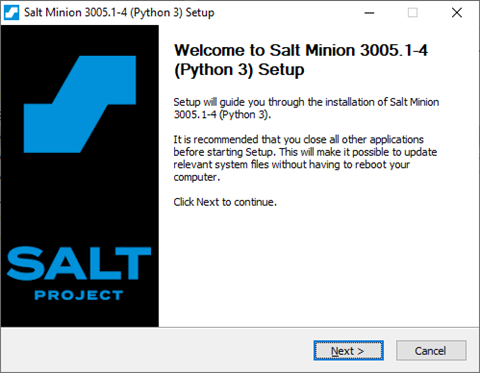
-
Click
I Agreein the license agreement window Fig. 3.
Figure 3. License agreement window
-
Specify the path to the client installation folder Fig. 4.
Figure 4. Destination folder selection window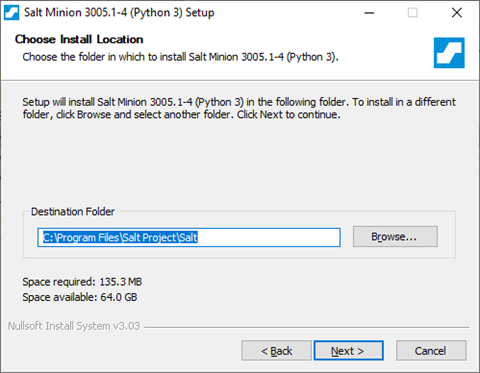
-
In the
salt-minionservice settings window, specify the dedicated server IP address in the first field.Do not change Minion Name: hostname and Default config Fig. 5.
Click
Installand wait for the client installation to complete.
Figure 5. Salt-minion service settings window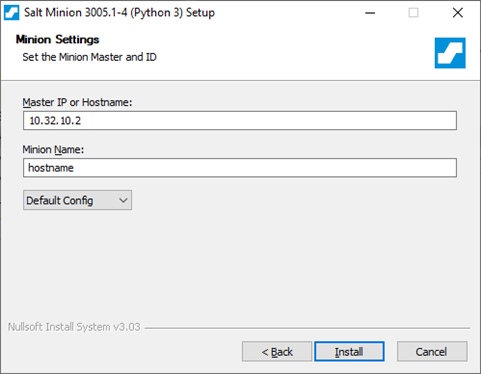
-
Click
Finishin the installation completion window Fig. 6.
Figure 6. Installation completion window
Install using Microsoft Active Directory Group Policies
-
Either select
Administrative Tools -> Group Policy Managementfrom the Start menu, or selectRunFig. 7.
Figure 7. Launch the Group Policy Management snap-in -
Right-click Group Policy Objects node in the domain object tree, and then select
NewFig. 8.
Figure 8. Create a Group Policy Object
-
In the dialog box, enter the name of the new GPO and click
ОК.In this example, the GPO is called Client Installation Fig. 9.
Figure 9. Specifying a name for the new GPO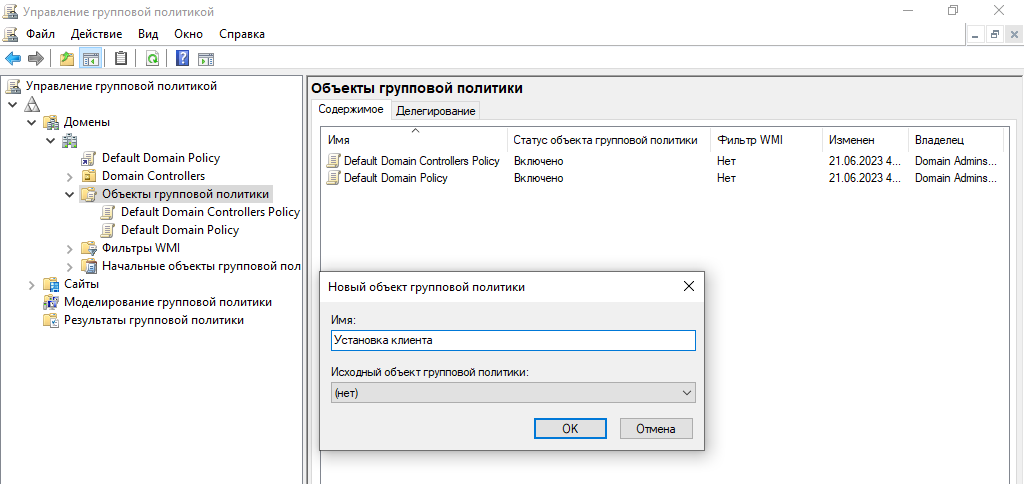
-
Right-click on the desired Organizational Unit in the domain object tree (in this example, Test OU), and then select Link an existing GPO Fig. 10.
Figure 10. Create an association between an Organizational Unit and a GPO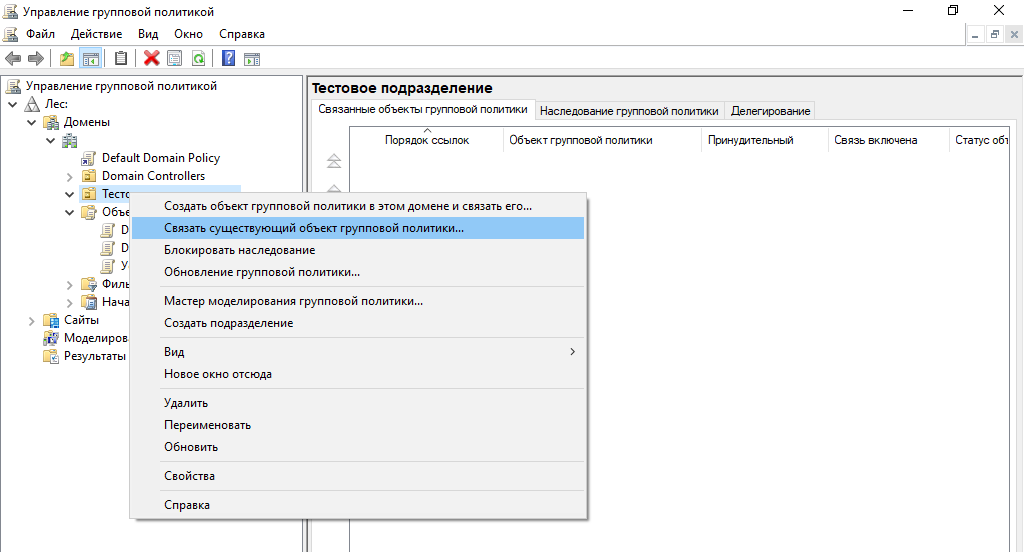
-
Select Client Installation in the Select Group Policy Object window.
Figure 11. Selecting a Group Policy Object
-
Right-click on the Client Installation object in the list of domain Group Policy objects, then select
EditFig. 12.
Figure 12. Editing a Group Policy Object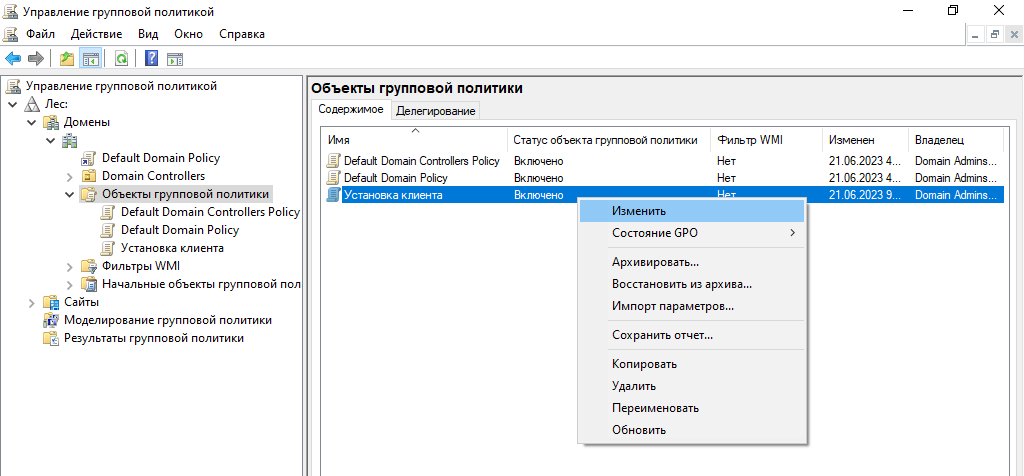
-
Select the Scripts item under the
Computer Configuration -> Windows Settingsnode Fig. 13. -
Right-click on the Startup script in the script list window, then select
PropertiesFig. 13.
Figure 13. Editing startup script properties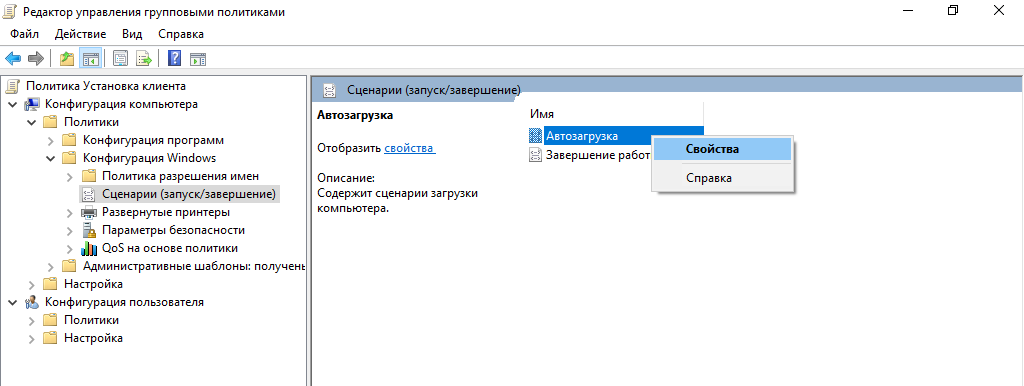
-
Click
Show Fileson the Scripts tab of the startup script properties window Fig. 14.
Figure 14. Startup script properties window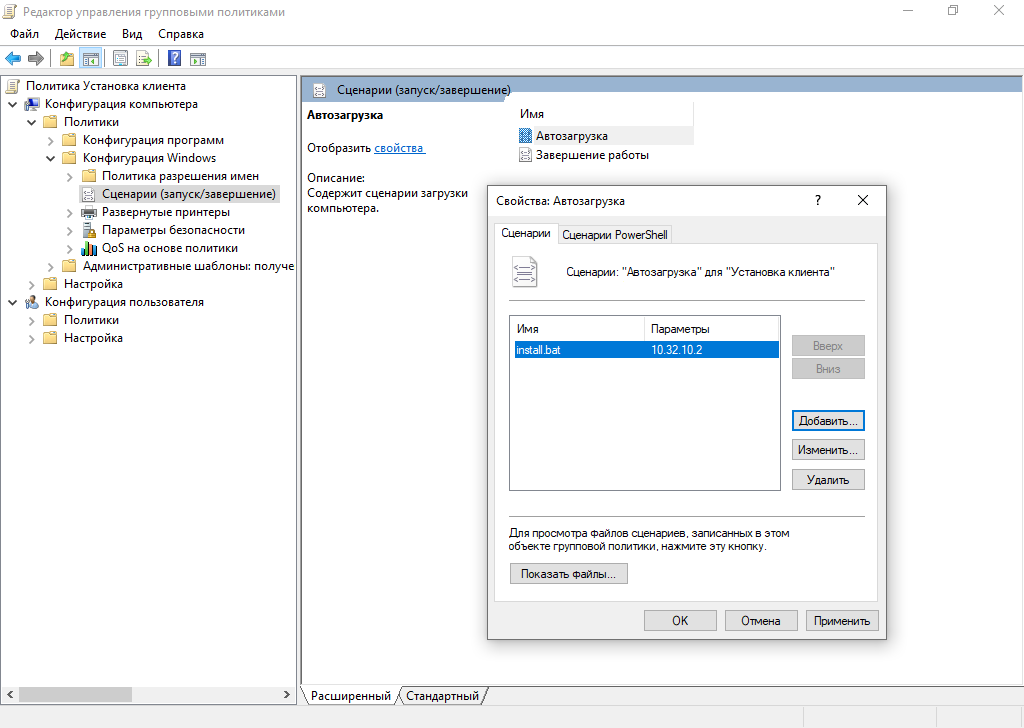
-
Copy the
install.batfile and the.exefiles of the installers for Windows 32-bit and 64-bit architectures to the startup script folder opened in Windows Explorer Fig. 15.
Figure 15. Copying files to the startup script folder
-
Close Explorer and click
Addon the Scripts tab of the startup script properties window Fig. 14. -
Specify the name
install.batand the dedicated IP address of the server, then clickОКFig. 16.
Figure 16. Specifying startup script parameters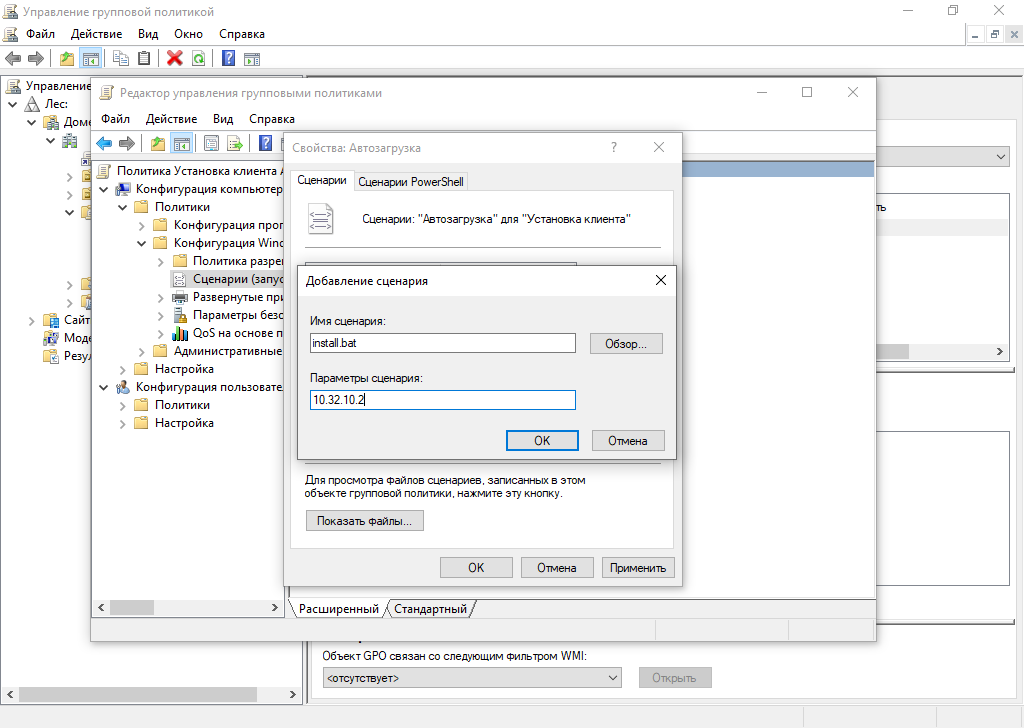
Reconnecting a minion to a different Master
If a minion was successfully connected to and managed by some Master, and then the address or network name of the Master was changed in the minion configuration, or the Master was removed and redeployed (while preserving its IP address or network name), the minion will not be able to authenticate to the new Master, because the public key of the Master stored on the minion and the public key of the new Master will be different.
The example below shows the output of a Windows minion in case of an authentication error.
2025-07-30 12:55:02,495 [salt.crypt :1285][ERROR ][5384] The master key has changed, the salt master could have been subverted, verify salt master's public key
2025-07-30 12:55:02,510 [salt.crypt :903 ][CRITICAL][5384] The Salt Master server's public key did not authenticate!
The master may need to be updated if it is a version of Salt lower than 3006.10, or
If you are confident that you are connecting to a valid Salt Master, then remove the master public key and restart the Salt Minion.
The master public key can be found at:
C:\ProgramData\Salt Project\Salt\conf\pki\minion\minion_master.pub
To resolve the issue, follow these steps:
On a Windows minion:- Stop the
salt-minionservice:net stop salt-minion - Delete the Master server public key file:
del C:\ProgramData\SaltProject\conf\pki\minion_master.pub - Start the
salt-minionservice:net start salt-minion
- Stop the
salt-minionservice:sudo systemctl stop salt-minion - Delete file with the Master server public key:
rm -v /etc/salt/pki/minion/minion_master.pub - Start the
salt-minionservice:sudo systemctl start salt-minion
Make sure that the minion can now execute commands from the Master.
This can be done by running a command like salt-call test.version.
For a detailed description of the mutual authentication procedure between the server and the minion, see the section:
Security / Encrypting client-server connections.